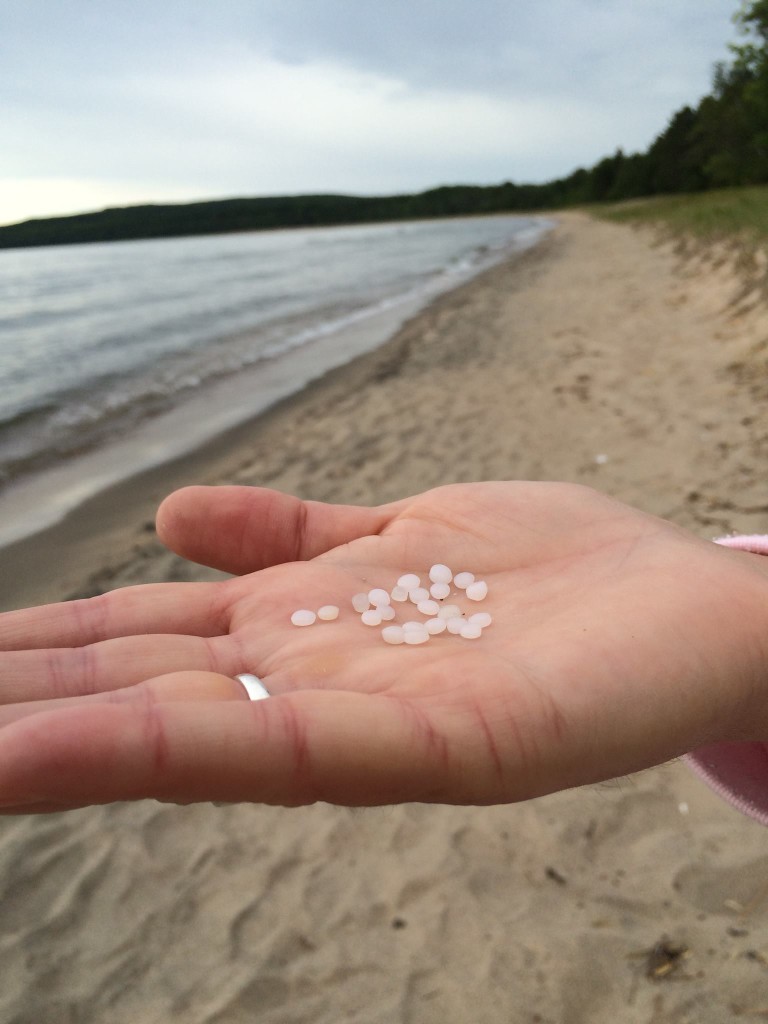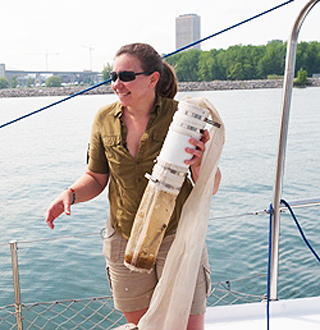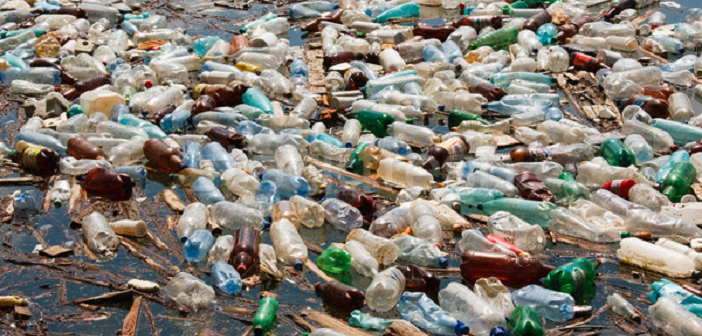
“The amount of shoreline that is being affected is ridiculous. I brought my four year old daughter to Pancake Bay last weekend and we picked nurdles for two hours. You can’t just look down and see them -you really have to look and move off some debris. We found them over and over again. It’s one of those things that people aren’t aware of because its not very visible.” ~Jeremy Frech, kayaker, angler, concerned citizen
This past August, Jeremy Frech, avid kayaker and fisherman, was paddling along the shores of Lake Superior. He pulled his kayak onto the beach of Pancake Bay, about 100 km north of the city of Sault Ste. Marie, and was startled to discover what he described as an ‘abundance of small white plastic beads’. Later that day, Frech travelled further north, 80 km or so, to Sand River to try to catch a few fish. These small white plastic pellets were there as well, in greater abundance, sprinkled in with debris fields and settlement spots along the coastline.
Concerned Frech contacted the Ministry of the Environment (MOE) with his discovery. The MOE connected the plastics to a train derailment back in January of 2008.
MOE spokesperson, Lisa Brigadyr, identified the plastics as ‘production pellets’. Production pellets, sometimes referred to as ‘nurdles’, are small but visible plastic pellets used in the manufacturing of other plastics. Recently, ‘nurdles’ –about the size of a lentil, have replaced packing Styrofoam peanuts and are used in myriad transportation processes.
According to Brigadry, the 2008 derailment resulted in one boxcar dumping its load of production pellets into Lake Superior.
“As a regulatory agency responsible for ensuring these types of incidents are remediated we did respond. The rail company [Canadian Pacific] conducted an appropriate clean up measure at the time of the incident and the majority of the clean-up was completed in 2008,” commented Brigadyr. “Unfortunately, there are areas of the shoreline where following heavy storms or a period of really high wave action these pellets still show up so we have worked continuously with the rail company with ongoing clean up when the discovery of these pellets are reported. The reality is that they just can’t all be recovered.”

“Most people don’t ask about what is at the bottom of the lake. It’s invisible. We don’t see it. But if you’re seeing plastics on the beach the chances of seeing plastics on the bottom of the Lake, and in greater amounts than what we see on land, is pretty good.” ~Dr. Patricia Corcoran, University of Western Ontario.
Given the teeny size of production pellets, one boxcar spill could very well have resulted in trillions of production pellets entering Lake Superior.
Dr. Patricia Corcoran, Associate Professor with the Department of Earth Sciences at Western University, is credited with making the first discovery of production pellets on the beaches of the Great Lakes in 2009. According to Dr. Corcoran, Lake Superior’s position at the top of the Great Lakes as well as the relatively low amount of industry along Superior, increases the likelihood that the majority of production pellets discovered by Frech can be attributed directly to the train derailment. Frech has also confirmed that his discovery of production pellets on six beaches between Sault Ste. Marie, Ontario and Wawa, Ontario are consistent in colour and size.
“If they’re the same size, the same colour and if their markings can be identified it would be quite easy to trace it back to one company,” explained Dr. Corcoran. “The nurdles discovered on the beaches around Lake Superior probably are all a result of the derailment. They’ve been circulating throughout the Lake for the past 6 years. Nurdles are so light- their density so low, that they easily get beached during storms. They may sit there for a while and then they’re taken back to the water by another storm event. That can happen over and over again. The fact that you are seeing pellets that look all the same points to that one main source.”
Dr. Corcoran began researching the presentation of production pellets along the shores of Lake Huron. Dr. Corcoran has since expanded her research team’s search to include the various shores of Lake Erie and Lake Ontario.
Of the presence of production pellets along Lake Ontario shorelines Dr. Corcoran remarked, “They are all different colours, different sizes, different markings. You just know that there are so many different companies that are just spilling them.”
The movement of nurdles towards water sources includes production pellets lost during transportation- via ship, transport or rail. Each time nurdles are moved, nurdles escape hitting the ground, eventually finding their way into streams or sewers which lead to open water sources. Sources within factories have also shared that when production pellets hit the factory floor, at the end of the day they are swept and sprayed down the drain.

“I think we have all heard about the gigantic plastic islands floating around in the world’s oceans but we haven’t really thought about plastics in the Great Lakes all that much. When we think about plastic, we think about the billions of plastic shopping bags everywhere, but what we don’t think, or even know much about, are a much more insidious form of plastic pollution. Tiny plastic microbeads found all manner of cosmetics and creams and beautiful body image products. Us women think about those little wrinkles and how to smooth them out a bit whether we are 16 or 50. I don’t think it is all that widely appreciated yet that these products contain hundreds of thousands of these microscopic plastic beads. When we wash the products off at the end of the day, they go down the drain and end up in the rivers and lakes. They are being consumed by the entire Great Lakes food chain from the fish to the plankton. It is a huge issue. But I think once people are educated about the problem, we can tackle it through our power as consumers. We aren’t going to stop wanting the wrinkles to go away. So we have to educate and promote products that do the same work without the plastic beads.” ~Joanie McGuffin, adventurer, conservationist
If you haven’t heard about production pellets until today you likely have heard about microbeads – miniscule polyethylene spheres, measuring anywhere from 0.1 micrometres to five millimeters in diameter, that have been injected into just about every cosmetic exfoliating scrub and personal care product such as toothpaste. Microbeads have also been used in research processes that include biomedical and health science research. However, production pellets and microbeads are just a couple of two-bit players in a much larger problem that is just beginning to gain attention in North America- microplastics.
Microplastics, which can include microbeads and production pellets, are small pieces of plastic that are typically less than 5 millimeters, or .2 inches, in size. These plastic particles evolve from the breakdown of larger plastic sources and even from plastic fibers shed from synthetic clothing in washing machines. Microplastics are often added to other products like paint or construction materials.
Speaking broadly of all plastic sources Dr. Corcoran commented, “In my mind Lake Superior wouldn’t have as much plastic as the other Lakes. Lake Superior is at the start of the system. So whatever is in Lake Superior is flowing downwards- if it doesn’t get caught up in organic debris, and what doesn’t get washed up on the shore will continue through the Great Lakes. It seems like everything will just be dumped into Lake Ontario. We’re seeing really high amounts of plastics- not just production pellets, in Lake Ontario.”
The discovery of microplastics in the Great Lakes is a relatively new find. In 2012, Dr. Sheri Mason, chemistry professor at the State University of New York at Fredonia, was recognized for first discovering the alarming abundance of microplastics in the Great Lakes. A personal growing awareness of the concerns raised by plastics in open water sources compelled Mason to conduct her own literature review on the matter. Her findings were minimal.
“Not only hadn’t anybody looked at plastic pollution in the Great Lakes but nobody had really looked at any freshwater system,” remarked Dr. Mason. “All the research at that point in time was really focused on saltwater. It was unusual given that a UN report released in 2001 indicated that 80% of what we find in the oceans come from land. So we know plastics are going through freshwater systems on its way from the land to the ocean.”
For the past three years Mason and her research team have been collecting and analyzing water samples from the Great Lakes. Like her colleague Dr. Corcoran, funding limitations and physical geography has made it difficult to study Lake Superior to the same degree as the Great Lakes south of the largest freshwater lake in the world.
“Lake Superior is our least well studied but the numbers we received from Lake Superior are almost the same as the numbers we obtained from Lake Huron,” commented Dr. Mason of the water sample analysis. “As we follow the flow of water the amount of plastic increases. So Lake Superior probably has less than the amount of plastic than Lake Huron and so on.”

Jeremy Frech collected 1,000’s of these lentil sized production pellets -often referred to as ‘nurdles’ along the myriad shorelines of Lake Superior this summer.
Water samples collected from the Great Lakes between 2012- 2013 showed that per square kilometer that Lake Superior and Lake Huron contained an average of 7,000 pieces of microplastic. In Lake Michigan 12,000 pieces of microplastic per square kilometer was found, in Lake Eerie- 46,000 pieces of microplastic per square kilometer and in Lake Ontario- 260,000 pieces of microplastic per square kilometer.
This information naturally begs the question, how does all of this plastic impact the food chain?
Though Dr. Mason and her colleagues are just setting out to answer this question, ten years of studies conducted on this very question as it relates to saltwater organisms has guided Dr. Mason’s research as she explores the impact of plastics upon freshwater organisms.
“We’re at the forefront with this question,” shared Dr. Mason. Dr. Mason and her team have examined the gastrointestinal tracts of 25 species of fish and the double crested cormorant. All species were found to have ingested plastic.
“We found that the amount of plastics increases as we go to higher trophic- or feeding levels. So things lower on the food chain, like the small shiners, have one to three pieces of plastics in the tracts. The perch had five to eight pieces and then working up to the double crested cormorant we saw an average of thirty-six plastic pieces in each bird.”
Dr. Mason is quick to clarify that further study is required to determine the effect of plastics on freshwater organisms but indicates that research of saltwater fish and plastics may lead to some similar conclusions.
“The saltwater studies show that plastics impact organisms in a multitude of ways with regard to these small microplastics which are so prevalent,” stated Dr. Mason. “The issue in the Great Lakes is largely the fact that plastic acts to move chemicals from the water into the organisms. As the plastic is sitting in the water the chemicals will absorb into the surface of the plastic and the fish ingests the plastic and these chemicals will desorb into the fish. And they may not necessarily kill it, much of these chemicals are more subtle in their impacts than that. But they will affect their reproductive ability, ability to swim- can they get away from predators? Decreased growth rate- things like that. They just don’t die. What concerns me is that people catch the fish, eat the fish and then eat the chemicals.”
What kind of chemicals should we be worried about regarding freshwater fish?
According to Dr. Mason a collection of 286 chemicals referred to as ‘polycyclic aromatic hydrocarbon’ or ‘PAH’s’ and ‘polychlorinated biphenyl’ or ‘PCB’s’ are a cause for concern. Studies have suggested that exposure to PAH’s can be associated with childhood asthma, low birth weight, increased levels of developmental delays and increased levels of anxiety or depression among children. Banned in the 1970’s, research demonstrated that PCB’s caused cancer in animals and were probable human carcinogens. Over forty decades later PCB’s continue to find a path to our water sources.
Dr. Mason was clear that further study is required to understand the relationship between the transference of chemicals absorbed by fish through plastic to humans who consume the fish. Dr. Mason also points out that the presentation of chemicals in fish is not a new discovery.

“What we find in the water comes from us which means we are the solution. This is definitely an environmental issue which on a very individual level we could be having a very huge impact by simply changing what we do day to day.” ~ Dr. Sheri Mason, University of New York at Fredonia
“We all know that the Great Lakes has fish advisories because there are chemicals in the fish,” stated Dr. Mason. “The awareness of the plastic in the water and being consumed by fish just means that this might be an additional way that those chemicals might get into the fish.
So what to do about the legacy of plastic?
“We need to take a multi-faceted approach,” commented Dr Mason. “The starting point should always be to look at yourself and to be really conscious of how plastic enters your life and then find ways to reduce its presence. Plastic is such a prevalent part of our society now that it is impossible to live without it. A significant difference can be made by eliminating the single use disposable plastics that enter our life everyday- grocery bags, food wrappers, straws. I can’t tell you how many straws we find in the water. And then if you want to do more- start pushing for legislative changes. Even what we use in our everyday life is a drop in the bucket compared to the amount of plastics used in industrial facilities I order to make all the plastic crap we use.”
Seven States across the US, including Wisconsin which is in part bordered by Lake Michigan to the east, and Lake Superior to the north, have passed legislation banning the manufacturing and sale of microbeads. Canadian law makers have been slower on the hop, but this past March the House of Commons voted unanimously in favour of moving towards a ban by approving a motion put forward by the NDP that microbeads should be listed as a toxic substance under the Environmental Protection Act.
Microbeads are just a small component contributing to the plague of microplastics floating in our Great Lakes but the problem created by us can be solved by us.
“There’s 35 million people that live on the Great Lake watershed,” encouraged Dr. Mason. “If each of us takes one less plastic bag each day can you imagine how many plastic bags that would eliminate over the course of a year? These small individual changes add up really quickly.”



1 Comment
This is a huge problem and solutions need to be investigated.
For those interested to know more this wikipedia article is helpful: https://en.m.wikipedia.org/wiki/Plastic_particle_water_pollution
While I understand the need to bring attention to this issue the picture used to cover this article, depicting plastic trash of all varieties is unnecessarily sensational.